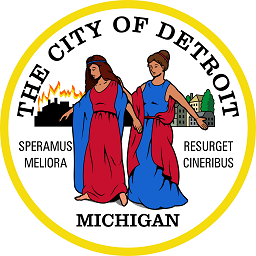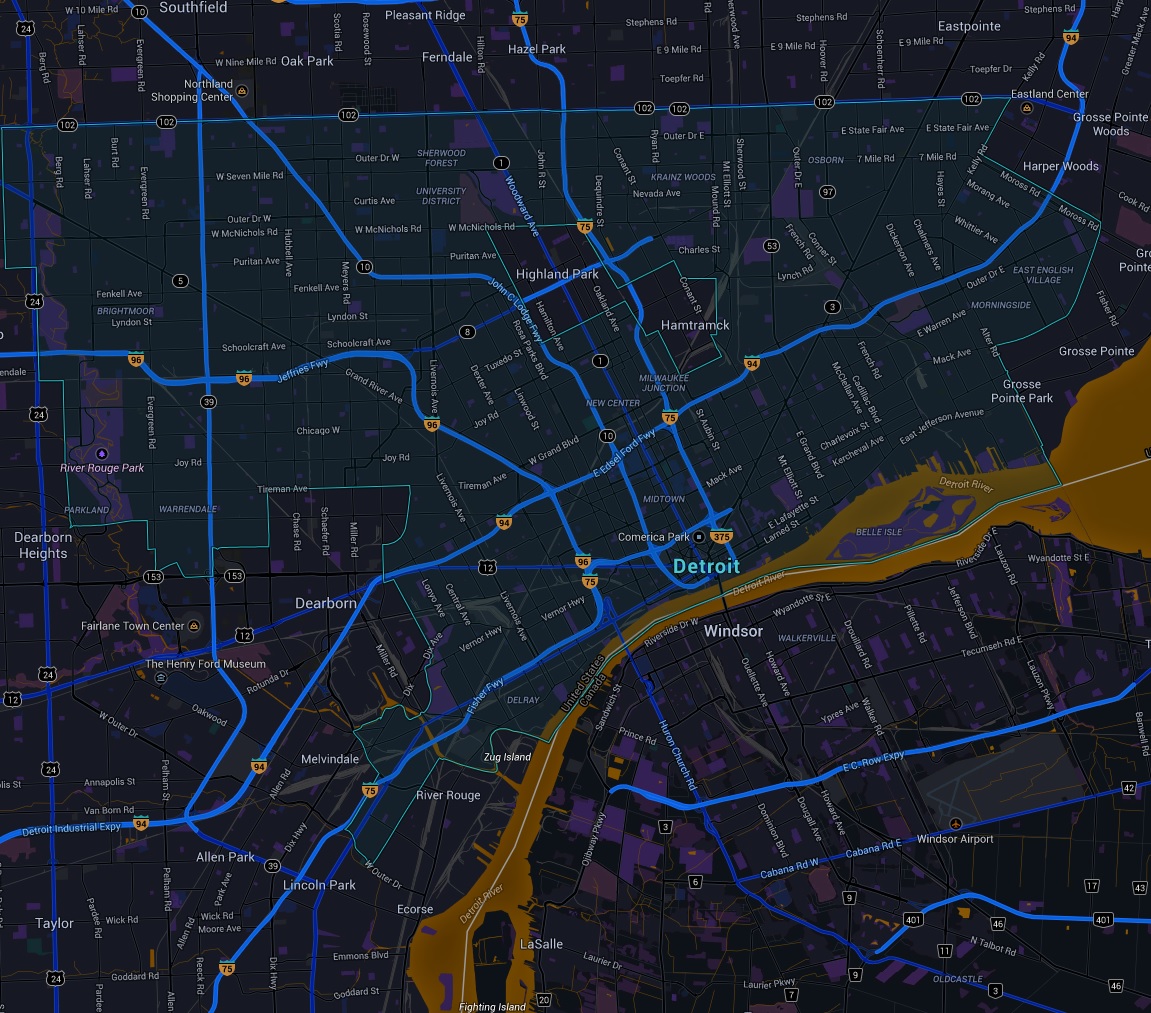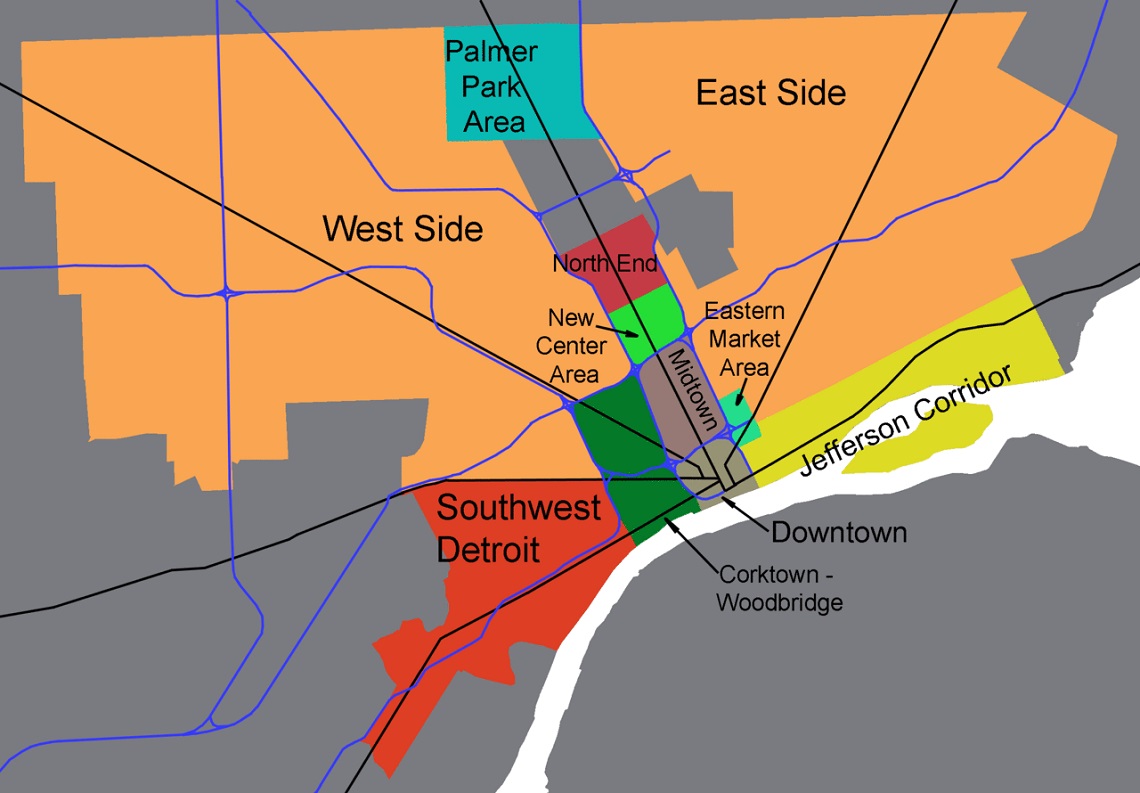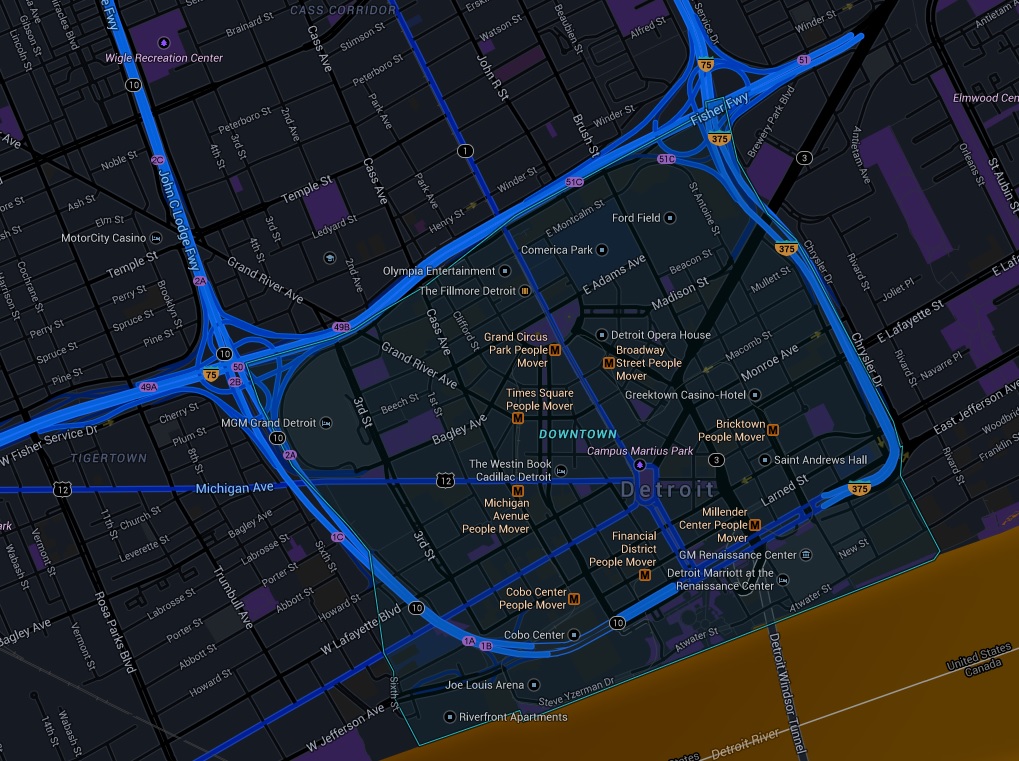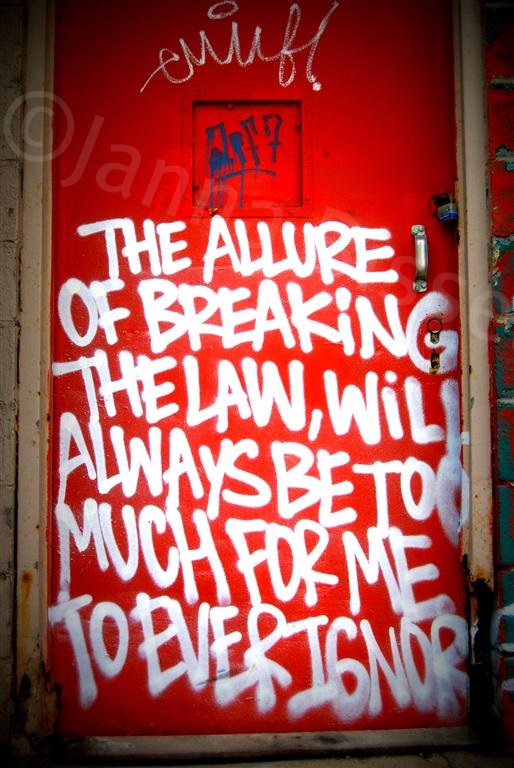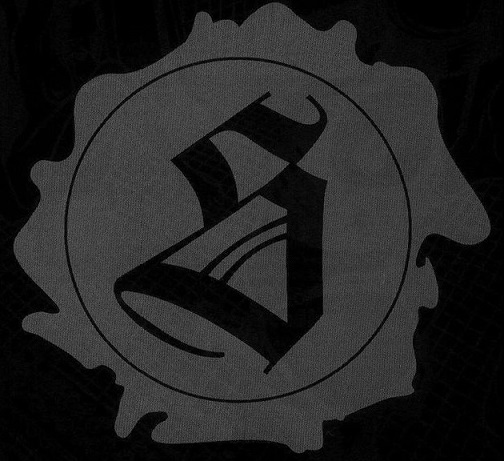Detroit
Contents
- 1 Quote
- 2 Appearance
- 3 Introduction
- 4 City Device
- 5 Motto
- 6 Climate
- 7 Districts
- 8 Demonym
- 9 Economy
- 10 Geography
- 11 History
- 11.1 Introduction
- 11.2 Beginnings
- 11.3 American Control
- 11.4 The 20th Century
- 12 Population
- 13 Arenas
- 14 Attractions
- 15 Bars and Clubs
- 16 Casinos
- 17 Cemeteries
- 18 City Government
- 19 Crime
- 20 Citizens of the City
- 21 Current Events
- 22 Fortifications
- 23 Galleries
- 24 Holy Ground
- 25 Hospitals
- 26 Hotels & Hostels
- 27 Landmarks
- 28 Mass Media
- 29 Monuments
- 30 Museums
- 31 Parks
- 32 Private Residences
- 33 Restaurants
- 34 Ruins
- 35 Schools
- 36 Shopping
- 37 Telecommunications
- 38 Theaters
- 39 Transportation
- 40 The Sabbat
- 40.1 The Archbishop
- 40.2 The Bishops
- 40.3 The Rank and File
- 40.3.1 American Gods
- 40.3.2 Cerberus: Newcomers to Detroit
- 40.3.3 Eastside Hoodoo Posse: White gangsta wannabees
- 40.3.4 Finger Lickin' Good
- 40.3.5 Flight of Devils
- 40.3.6 Gangsta Funk
- 40.3.7 Gilded Age
- 40.3.8 Grave Interest: A Coven of Necronomists
- 40.3.9 Misericorde: A Pack of Blackhand Killers
- 40.3.10 Money Shot: The Catharist Elite
- 40.3.11 The Morlocks: The Nosferatu antitribu
- 40.3.12 Penny Dreadful
- 40.3.13 Two Demons Fighting: Goth Sabbat
- 40.3.14 The Prophet's Chosen
- 40.3.15 Urban Blight
- 40.4 Nomadic Packs
- 41 Websites
Quote

“Detroit is largely composed, today, of seemingly endless square miles of low-density failure.” -― Jane Jacobs, The Death and Life of Great American Cities
Appearance
Introduction
Detroit is the most populous city in the U.S. state of Michigan and the largest city on the United States–Canada border. It is the seat of Wayne County, the most populous county in the state. It is a primary business, cultural, financial and transportation center in the Metro Detroit area, a region of 5.3 million people. It is a major port on the Detroit River, a strait that connects the Great Lakes system to the Saint Lawrence Seaway. It was founded on July 24, 1701, by the French explorer and adventurer Antoine Laumet de La Mothe, sieur de Cadillac and a party of settlers.
The Detroit area emerged as a significant metropolitan region within the United States in the early 20th century, and this trend only hastened in the 1950s and 1960s, with the construction of a regional freeway system. Detroit is the center of a three-county Urban Area (population 3,734,090, area of 1,337 square miles (3,460 km2), a 2010 United States Census) six-county Metropolitan Statistical Area (2010 Census population of 4,296,250, area of 3,913 square miles [10,130 km2]), and a nine-county Combined Statistical Area (2010 Census population of 5,218,852, area of 5,814 square miles [15,060 km2]). The Detroit–Windsor area, a commercial link straddling the Canada–U.S. border, has a total population of about 5,700,000. The Detroit metropolitan region holds roughly one-half of Michigan's population.
Known as the world's automotive center, "Detroit" is a metonym for the American automobile industry. Detroit's auto industry was an important element of the American "Arsenal of Democracy" supporting the Allied powers during World War II. It is an important source of popular music legacies celebrated by the city's two familiar nicknames, the Motor City and Motown. Other nicknames arose in the 20th century, including City of Champions, beginning in the 1930s for its successes in individual and team sport; The D; Hockeytown (a trademark owned by the city's NHL club, the Red Wings); Rock City (after the Kiss song "Detroit Rock City"); and The 313 (its telephone area code).
Between 2000 and 2010 the city's population fell by 25 percent, changing its ranking from the nation's 10th-largest city to 18th. In 2010, the city had a population of 713,777, more than a 60 percent drop from a peak population of over 1.8 million at the 1950 census. This resulted from suburbanization, industrial restructuring and the decline of Detroit's economic strength. Following the shift of population and jobs to its suburbs or other states or nations, the city focused on reestablishing itself as the metropolitan region's employment and economic center. Downtown Detroit has held an increased role as an entertainment destination in the 21st century, with the restoration of several historic theaters, several new sports stadiums, three new stadiums, and a riverfront revitalization project. More recently, the population of Downtown Detroit, Midtown Detroit, and a handful of other neighborhoods has increased. Many other neighborhoods remain distressed and even heavily abandoned.
The Governor of Michigan, Rick Snyder, declared a financial emergency for the city in March 2013, appointing an emergency manager. On July 18, 2013, Detroit filed the largest municipal bankruptcy case in U.S. history. It was declared bankrupt by Judge Steven W. Rhodes of the Bankruptcy Court for the Eastern District of Michigan on December 3, 2013; he cited its $18.5 billion debt and declared that negotiations with its thousands of creditors were unfeasible. On November 7, 2014, Judge Rhodes approved the city's bankruptcy plan, allowing the city to begin the process of exiting bankruptcy. The City of Detroit successfully left Chapter 9 municipal bankruptcy with all finances handed back to Detroit beginning at midnight on December 11, 2014.
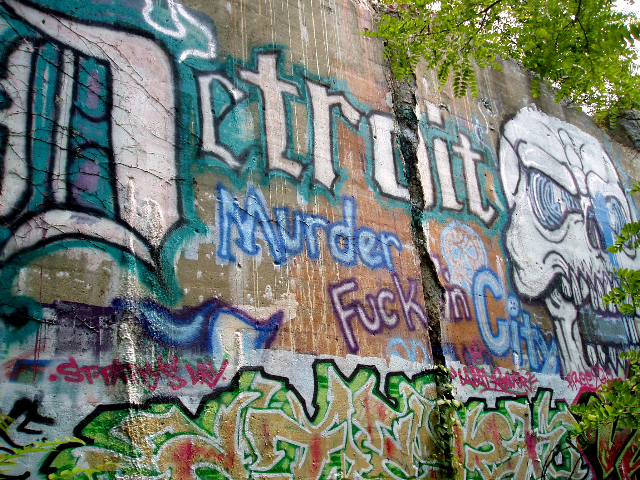
"Once the hub of the United States' automotive manufacturing, Detroit, Michigan has become a shell of its former industrial self. Detroit is valuable territory for the Sabbat despite its economic woes, and the sect seeks to revitalize the city with a shift in industrial focus. With one of the highest murder rates in the United States, Detroit (which has been known as "the murder capital of the U.S.") provides ample feeding grounds for its dwellers. Unlike some of their brethren to the south, the Sabbat of Detroit do not concentrate on capturing neighboring Camarilla cities. Rather, the city's vampires focus on bolstering the flagging fortunes of their home. After all, the Sabbat must have the proper resources if it is to launch a successful attack..." -- Ja'ala Eli, Keeper of Chronicles
City Device
Motto
Speramus Meliora; Resurget Cineribus -- (Latin: We Hope For Better Things; It Shall Rise From the Ashes)
Climate
Detroit and the rest of southeastern Michigan have a humid continental climate which is influenced by the Great Lakes. Winters are cold, with moderate snowfall and temperatures not rising above freezing on an average 44 days annually, while dropping to or below 0 °F (−18 °C) on an average 4.4 days a year; summers are warm to hot with temperatures exceeding 90 °F (32 °C) on 12 days.[98] The warm season runs from May to September. The monthly daily mean temperature ranges from 25.6 °F (−3.6 °C) in January to 73.6 °F (23.1 °C) in July. Official temperature extremes range from 105 °F (41 °C) on July 24, 1934 down to −21 °F (−29 °C) on January 21, 1984; the record low maximum is −4 °F (−20 °C) on January 19, 1994, while, conversely the record high minimum is 80 °F (27 °C) on August 1, 2006, the most recent of five occurrences. A decade or two may pass between readings of 100 °F (38 °C) or higher, which last occurred July 17, 2012. The average window for freezing temperatures is October 20 thru April 22, allowing a growing season of 180 days.
Precipitation is moderate and somewhat evenly distributed throughout the year, although the warmer months such as May and June average more, averaging 33.5 inches (850 mm) annually, but historically ranging from 20.49 in (520 mm) in 1963 to 47.70 in (1,212 mm) in 2011. Snowfall, which typically falls in measurable amounts between November 15 through April 4 (occasionally in October and very rarely in May), averages 42.5 inches (108 cm) per season, although historically ranging from 11.5 in (29 cm) in 1881−82 to 94.9 in (241 cm) in 2013−14. A thick snowpack is not often seen, with an average of only 27.5 days with 3 in (7.6 cm) or more of snow cover. Thunderstorms are frequent in the Detroit area. These usually occur during spring and summer.
Districts
Downtown Detroit
Corktown - Woodbridge
[[]]
Jefferson Corridor
[[]]
Eastern Market Area
[[]]
Midtown
[[]]
Southwest Detroit
[[]]
New Center Area
[[]]
North End
[[]]
Palmer Park Area
[[]]
East Side
[[]]
West Side
[[]]
Independent Cities of the Detroit Metro
Hamtramck -- Michigan's most ethnically diverse city.
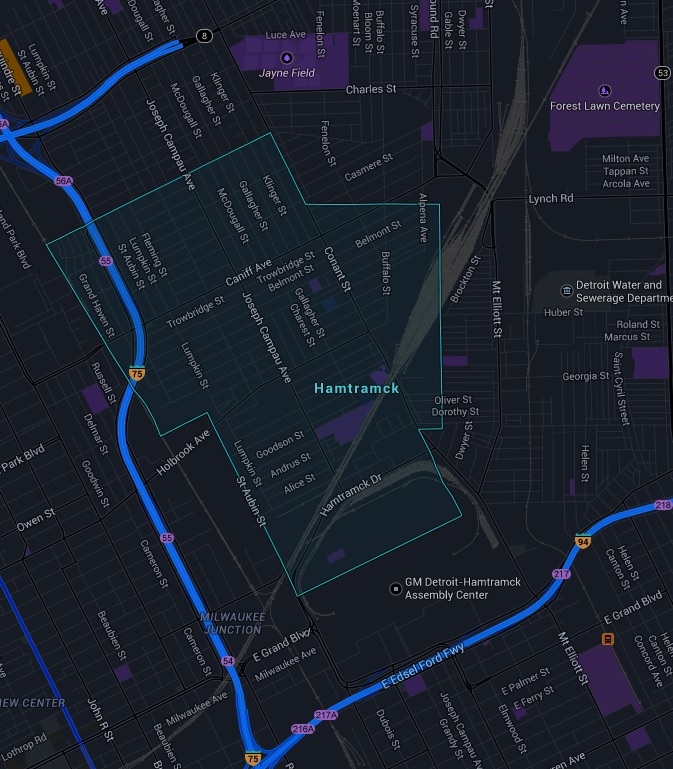
http://en.wikipedia.org/wiki/Hamtramck,_Michigan
Highland Park

http://en.wikipedia.org/wiki/Highland_Park,_Michigan
Demonym
Detroiter
Economy
Geography
History
Introduction
The city of Detroit, the largest city in the state of Michigan, developed from a small fur trading post of New France to a world-class industrial powerhouse and the fourth largest American city by the mid 20th century. The city, settled in 1701, is the first European settlement above tidewater in North America. After a devastating fire in 1805, Augustus B. Woodward devised a street plan similar to Pierre Charles L'Enfant's design for Washington, D.C. Detroit's monumental avenues and traffic circles fan out in radial fashion from Campus Martius Park in the heart of the city, which facilitates traffic patterns along the city's tree-lined boulevards and parks. Main thoroughfares radiate outward from the city center like spokes in a wheel.
During the 19th century, Detroit grew into a thriving hub of commerce and industry, and the city spread along Jefferson Avenue, with multiple manufacturing firms taking advantage of the transportation resources afforded by the river and a parallel rail line. In the late 19th century several Gilded Age mansions were built just east of Detroit's current downtown. Detroit was referred to by some as the Paris of the West for its architecture, and for Washington Boulevard, recently electrified by Thomas Edison. Throughout the 20th century various skyscrapers were built centered on Detroit's downtown.
Following World War II, the auto industry boomed and the metropolitan area became one of the largest in the United States. Immigrants and migrants have contributed significantly to Detroit's economy and culture. In the 1990s and the new millennium, the city has experienced increased revitalization. Many areas of the city are listed in the National Register of Historic Places and include National Historic Landmarks. The suburbs continue to grow, but the population of the city itself has plunged from a high of 1,849,568 in 1950 to 710,000 in 2010, with the non-Hispanic white element falling from 816,000 to 56,000.
Beginnings
The first recorded mention of the site was in 1670, when French missionaries found a stone idol venerated by the Indians there and destroyed it with an axe. Early settlers planted twelve missionary pear trees "named for the twelve Apostles" on the grounds of what is now Waterworks Park.
The city name comes from the Detroit River (French: le détroit du Lac Érie), meaning the strait of Lake Erie, linking Lake Huron and Lake Erie; in the historical context, the strait included Lake St. Clair and the St. Clair River. The sieur de Cadillac in 1698 proposed to his government in Paris that Detroit be established as a shelter for displaced Indian allies. Paris approved and in 1701 Cadillac led a party of 100 Frenchmen to establish a post called Fort Pontchartrain du Détroit, naming it after his sponsor the comte de Pontchartrain, Minister of Marine under Louis XIV. In 1704 he was given ownership over the strenuous opposition of officials in New France. An investigation by de Pontchartrain showed Cadillac was a tyrannical profiteer whose mischief hurt the French cause, so Cadillac was removed and sent to faraway New Orleans as governor of Louisiana.
Ste. Anne de Détroit, founded 1701, is the second oldest continuously operating Catholic parish in the United States; it was the first building erected in Detroit.
Grants of free land attracted families to Detroit, which grew to 800 people in 1765. The main business was trading furs with the Indians, using goods supplied from Montreal. It was the largest French village between Montreal and New Orleans. Francois Marie Picoté, sieur de Belestre (Montreal 1719–1793), the last French commander at Fort Detroit (1758–1760), surrendered on November 29, 1760 to the British. They shortened the name to Detroit.
Demonstrating their independent power, several tribes in the region collaborated in Pontiac's Rebellion in 1763; they overran many smaller forts but could not subdue Detroit.
American Control
Detroit was the goal of various American campaigns during the American Revolution, but logistical difficulties in the North American frontier and American Indian allies of Great Britain would keep any armed rebel force from reaching the Detroit area. In the Treaty of Paris (1783), Great Britain ceded territory that included Detroit to the newly recognized United States, though in reality it remained under British control. Great Britain continued to trade with and defend her native allies in the area, and supplied local nations with weapons to harass American settlers and soldiers. The British left in 1796 following the Jay Treaty. In 1794, a Native American alliance, that had received some support and encouragement from the British, was decisively defeated by General Anthony Wayne at the Battle of Fallen Timbers near Toledo, Ohio. Wayne negotiated the Treaty of Greenville (1795) with many of these nations, in which tribes ceded the area of Fort Detroit to the United States.
Father Gabriel Richard arrived at Ste. Anne's in 1796. He helped start the school which evolved into the University of Michigan, started primary schools for white boys and girls as well as for Indians, as a territorial representative to U.S. Congress helped establish a road-building project that connected Detroit and Chicago, and brought the first printing press to Michigan which printed the first Michigan newspaper. In 1805, fire destroyed most of the settlement. A river warehouse and brick chimneys of the wooden homes were the sole structures to survive.[10] Detroit's motto and seal (as on the Flag) reflect this fire.
First Incorporation
Detroit was incorporated as a town by the legislature of the Northwest Territory at Chillicothe, Ohio, on January 18, 1802, effective February 1, 1802. Government was administered by a five-person board of trustees and there was no office of mayor. Following this, Ohio became a state and the eastern half of Michigan was attached to the Indiana Territory.
The Woodward Plan
Before the new territorial government officially began, a fire destroyed nearly all of Detroit on June 11, 1805. The Michigan Territory was established effective June 30, 1805, as a separate territory with Detroit as the capital. The newly appointed governor, William Hull, and the territorial judges (Augustus B. Woodward, Frederick Bates, James Witherell, and John Griffin), constituted the territorial government. They convinced the U.S. Congress to pass an act on April 21, 1806, which authorized them to lay out a town that included all of the old town of Detroit plus an additional 10,000 acres (40 km²) to be used as compensation for persons who lost their house in the fire.
After the fire of 1805, Justice Augustus B. Woodward devised a plan similar to Pierre Charles L'Enfant's design for Washington, D.C. Detroit's monumental avenues and traffic circles fan out in a baroque styled radial fashion from Grand Circus Park in the heart of the city's theater district, which facilitates traffic patterns along the city's tree-lined boulevards and parks. Main thoroughfares radiate outward from the city center like spokes in a wheel.
Second City Incorporation
On September 13, 1806, the territorial government passed an act incorporating the new city of Detroit. The governor appointed Solomon Sibley as mayor. Shortly afterward, Sibley resigned and Elijah Brush was appointed in his stead. The mayor was appointed by the governor and, under the act of incorporation, was able to disapprove legislation passed by the popularly elected council without any recourse for overriding the mayor. Because of this, many felt that the real aim of the governor in incorporating the city was to remove the popularly elected town officers and exert a more direct influence over governance of the city. This form of government was extremely unpopular, and was repealed on February 4, 1809. However, to prevent resurrection of the popularly elected town government, on September 16, 1810, an act passed repealing all laws pertaining to Michigan that had been passed by the Legislature of the Northwest Territory. This effectively eradicated any trace of legitimacy for the former popularly elected town government.
War of 1812
In the War of 1812, Governor Hull surrendered Detroit to a smaller British force which threatened to allow its Indian allies to kill all American prisoners. The British had bluffed the Americans into believing there were thousands of native troops. Tecumseh marched his native troops through a clearing and then circled the same troops through the clearing again to make it seem there was a much larger native force. Hull was convicted of cowardice and sentenced to death by a court martial, but received a presidential pardon. The U.S. Army recaptured Detroit in 1813 after the British abandoned it and used it as a base to invade Canada and permanently end the threat of Indian raids on American settlements. After the British abandoned Detroit, American forces caught up to the escaping British and natives, and killed Tecumseh. Lewis Cass, as territorial governor, on October 24, 1815, restored control of local affairs to the people of Detroit, with the election of a five-person board of trustees and enactment of a charter for the city of Detroit.
The First American Civil War
Prior to the American Civil War, the city's access to the Canadian border made it a key stop for runaway slaves along the underground railroad. The Michigan Soldiers' and Sailors' Monument in Detroit's Campus Martius Park commemorates the state's role in the American Civil War. Thousands of Detroiters formed volunteer regiments, including the 24th Michigan Volunteer Infantry Regiment (part of the legendary Iron Brigade) which fought with distinction and suffered 82% casualties at Gettysburg in 1863. Abraham Lincoln is quoted as saying Thank God for Michigan! Following Lincoln's assassination, General George Armstrong Custer delivered a eulogy to the thousands gathered near Campus Martius Park. Custer led the Michigan Brigade during the American Civil War and called them the Wolverines.
The Detroit race riot of 1863 occurred on March 6, 1863 and was the city's first such incident, as Irish and German Catholics resisted the mandatory draft laws. At the time, it was reported as "the bloodiest day that ever dawned upon Detroit." The casualties of the day included at least two people dead, and many others injured, mostly African-American, 35 buildings were burned to the ground, and a number of other buildings were damaged by fire.
Rise of the Industrial Age
Detroit's central location in the Great Lakes Region has contributed to its status as a major center for commerce and global trade. As Detroit grew, it emerged as a U.S. transportation hub linking the Great Lakes system of waterways to the Erie Canal and to rail lines. Pharmaceutical firms such as Parke-Davis in the 1870s and the Frederick Stearns Company in the 1890s established a centers between East Jefferson Avenue. Globe Tobacco built a manufacturing facility closer to downtown in 1888.
The rise of manufacturing led to a new class of wealthy industrialists, entrepreneurs, and professionals. Some of these nouveau riche built along East Jefferson, resulting in structures such as the Thomas A. Parker House (1868), the Croul-Palms House (1881), the William H. Wells House (1889), the John N. Bagley House (1889), and the Frederick K. Stearns House (1902).
Detroit began increasingly to expand, and other citizens pushed north of downtown, building houses along Woodward in what was at the time a quiet residential area. The city has many restored historic Victorian structures, notably those in the Brush Park and East Ferry Avenue historic districts. The Elisha Taylor House (1870) and the Hudson-Evans House (1872) are both in Brush Park; the Col. Frank J. Hecker House (1888) and the Charles Lang Freer House (1887) are in the East Ferry Avenue neighborhood. Near the end of the 19th century, apartment living became more acceptable for affluent middle-class families, and upscale apartments, such as the Coronado Apartments (1894), the Verona Apartments (1894), the Palms Apartments (1903), the Davenport Apartments (1905) in the Cass-Davenport Historic District, and the Garden Court Apartments (1915) were constructed to meet the new demand.
These well-to-do late-19th-century residents also funded the construction of a spate of churches, such as the Cass Avenue Methodist Episcopal Church (1883), the First Presbyterian Church (1889), the Trinity Episcopal Church (1890) (built by James E. Scripps), and the First Unitarian Church (1890).
The 19th Century and Immigration
Detroit has long been a city of immigrants, from the early French and English settlers in the 18th century, through the Irish who settled in the Corktown neighborhood in the 1840s, and the Germans who comprised the largest group. Significant contingents during this period included German and Polish immigrants who settled in Detroit in the 1860-1890s.
Conditions were especially favorable for the Irish Catholics. Vinyard finds that they enjoyed many opportunities and suffered "negligible religious prejudice." They were especially successful in politics, government service, dockyard and construction jobs, and built numerous churches. They funded the migration of relatives from Ireland. They took very active leadership roles in the Democratic Party and labor unions.
Immigrants opened businesses and established communities. German immigrants established German-speaking churches, primarily on the east side of the city, including Saint John's-St. Luke's Evangelical Church (1872), St. Joseph Catholic Church (1873), and Sacred Heart Roman Catholic Church (1875), as well as social clubs such as the Harmonie Club (1894) and west-side churches such as St. Boniface (1882) and Gethsemane Evangelical Lutheran Church (1891).
Close behind, a wave of Polish immigrants established east-side Roman Catholic parishes such as St. Albertus (1885), Sweetest Heart Of Mary (1893), St. Josaphat's (1901), St. Stanislaus (1911), and St. Thomas the Apostle Catholic Church (1923). The Poles also settled on the west side, founding West Side Dom Polski (1916). The son of Prussian Polish immigrants, Rev. John A. Lemke, born in Detroit on February 10, 1866, was the first American-born Roman Catholic Priest of Polish descent to be ordained in America. He was baptised at St. Mary Roman Catholic Church (1843), at the corner of St. Antoine and Croghan (Monroe), on February 18, 1866, attended St. Albertus for his primary education, and studied at Detroit College which is now the University of Detroit Mercy where he received a Bachelor's degree in 1884; then, after attending St. Mary's in Baltimore, he completed his theological studies at St. Francis Seminary in Monroe, Michigan, and he was ordained by the Bishop John Samuel Foley in 1889. The Catholics were especially energetic in building churches, schools, orphanages, hospitals and other charitable institutions.
Nearly nine out of ten Detroiters in 1900 (87%) lived in single-family homes. German, Polish, and Irish ethnics were more likely to be home owners than old stock Americans. Most ethnics built their own home with the aid of their countrymen, or if still saving the purchase price they rented from fellow ethnics. They used an informal, localized, ethnically controlled housing market that was quite distinct from the professionally operated housing market. Thus home-ownership in Detroit was rooted in the city's ethnic neighborhoods and was, in 1900, not attributable to the middle class.
Mayor Hazen Pingree
In 1887, John Pridgeon, Jr., a Democrat was elected mayor in a landslide after his Republican opponent endorsed prohibition in the heavily German city. Pridgeon's term was besmirched by multiple scandals involving the Common Council, city commissioners, grand jury investigations, and multiple indictments for bribery and graft. In 1889 Republicans recouped and called for "good government" by nominating a businessman with no political experience, Hazen S. Pingree after a colorful campaign in which Pingree revealed his tolerance by making a circuit of saloons. One of his first projects was simply paving the streets—only four streets were paved, and The Detroit Journal described the rest as "150 miles of rotting, rutted, lumpy, dilapidated paving." In hot weather some stretches oozed pitch and resin and occasionally caught fire from discarded cigar butts. Warning repeatedly against the dangers of government by the corporations, he launched nationally visible crusades against Detroit's streetcar, gas, electric, and telephone companies. He successfully forced rate reductions that won him widespread popularity. He won public approval for a citizen-owned electric light plant, and became a national spokesman for municipal ownership and close regulation of utilities and street railways. When the nationwide Panic of 1893 pushed the nation into a deep depression (1893–97), he won approval by opening empty lots to garden farming – people called them "Pingree's potato patches." He was a steadfast Republican, and had nothing to do with the Populist Party that had considerable support among labor union members. Pingree added to the old stock Yankee Republican base by making large inroads into the German, Polish and Canadian elements. He was reelected in 1891, 1893 and 1895. Pingree was one of the most influential American mayors in the 1890s – historians now rated him number 4 among all American mayors, and see him as one of the earliest leaders of the Progressive Era. He supported the gold standard in 1896, and worked hard to carry the city and state for William McKinley over silverite William Jennings Bryan in the intensely competitive 1896 presidential election. McKinley carried the city and state and Pingree was elected governor of Michigan.
The 20th Century
The Progressive Movement
Progressivism was energized by upper middle class men and women who felt a civic duty to uplift society by freeing it from the tyranny of corrupt politicians who worked hand in hand with unscrupulous saloonkeepers. A representative leader was automaker Henry M. Leland of the Detroit Citizens League. Supported by Detroit's business, professional, and Protestant religious communities, the League campaigned for a new city charter, an anti-saloon ordinance, and the open shop whereby a worker could get a job even if he did not belong to a labor union.
Henry Ford and the Automotive Industry
A thriving carriage trade set the stage for the work of Henry Ford, whose automobile Highland Park Ford Plant in 1910 revolutionized not only automobile manufacturing but virtually created the concept of the assembly line and mass production. Ford's manufacturing innovations were soon adopted by rival automobile manufacturers, most of whom, and their parts suppliers, were headquartered in the Detroit metropolitan area, establishing the city's fame as the world's car capital.
Around the start of the 20th century, entrepreneurs in the Detroit area—notably Henry Ford—forged into production of the automobile, capitalizing on the already-existing machine tool and coach-building industry in the city. Early automotive production is recognizable by structures such as Ford's Piquette Plant (1904) (a National Historic Landmark), and multiple structures in the surrounding Piquette Avenue Industrial Historic District (including the now-destroyed E-M-F/Studebaker Plant, 1906) and the New Amsterdam Historic District (including the original Cadillac factory, 1905) and small factories such as the Crescent Brass and Pin Company Building (1905).
Automobile assembly and associated manufacturing soon dominated Detroit, and the newly minted automotive magnates built commercial and office buildings such as General Motors Building (1919), the General Motors Research Laboratory (1928), and the Fisher Building (1928).
Ford revolutionized labor relations with his high wage policy that brought in the best workers in Detroit, and made "Fordism" world famous. He began with a $5 a day minimum wage in 1910, about double the going rate at rival firms. It succeeded in stopping the massive turnover rate, raised productivity, lowered overall labor costs and helped to propel the Model T to industry dominance. By the 1920s, however, Ford's formula of cheap cars with few options fell behind General Motors, which emphasized upscale quality and variety, and provided financing for car buyers.
The development of the automobile industry led to rising demands for labor, which were filled by huge numbers of newcomers from Europe. Between 1900 and 1930, the city's population soared from 265,000 to over 1.5 million, pushing the boundaries of the city outward. The population boom led to the construction of apartment buildings across the city, aimed at the middle-class auto worker. These include the Somerset Apartments (1922), the Garden Court Apartments (1915), and the Manchester Apartments (1915).
The rise of the automobile also required rethinking transportation within the city. The Chestnut Street-Grand Trunk Railroad bridge (1929) was a result of a grade separation that unsnarled train and automobile traffic. The Fort Street-Pleasant Street and Norfolk & Western Railroad Viaduct (1928) was a product of the same program, routing trucking traffic over the train traffic. And the West Jefferson Avenue-Rouge River Bridge (1922) allowed the Rouge River to be expanded for barge traffic.
Reinhold Niebuhr
Reinhold Niebuhr, a German-American Protestant minister trained at Yale Divinity School became nationally famous as a Detroit minister who attacked the KKK, which was strong among white Protestants in the city. In an era when Henry Ford was an American icon, Niebuhr attracted national attention by criticizing the auto industry. He preached the Social Gospel, attacking what he considered the brutalization and insecurity of Ford workers. Niebuhr had moved to the left and was troubled by the demoralizing effects of industrialism on workers. He became an outspoken critic of Ford and allowed union organizers to use his pulpit to expound their message of workers' rights. Niebuhr attacked poor conditions created by the assembly lines and erratic employment practices.
Niebuhr rejected the liberal optimism that prevailed in the 1920s. He wrote in his diary: "We went through one of the big automobile factories to-day. . . . The foundry interested me particularly. The heat was terrific. The men seemed weary. Here manual labor is a drudgery and toil is slavery. The men cannot possibly find any satisfaction in their work. They simply work to make a living. Their sweat and their dull pain are part of the price paid for the fine cars we all run. And most of us run the cars without knowing what price is being paid for them. . . . We are all responsible. We all want the things which the factory produces and none of us is sensitive enough to care how much in human values the efficiency of the modern factory costs."
The historian Ronald H. Stone thinks that Niebuhr never talked to the assembly line workers (many of his parishioners were skilled craftsmen) but projected feelings onto them after discussions with Rev. Samuel Marquis. As some studies of assembly line workers have shown, the work may have been dull, but workers had complex motivations and could find ways to make meaning of their experiences; many boasted about their jobs and tried hard to place their sons on the assembly line. Ford tried but failed to control work habits.
Sociologists who interviewed workers concluded that they were more interested in controlling their home lives than their work lives. The Ford solution was welfare capitalism, paying relatively high wages with added benefits, such as vacations and retirement, that reduced turnover and appealed primarily to family men. Link and Link conclude that by tying half a man's wages to the company's profit, Ford managers offered "a highly successful wage incentive plan that simultaneously increased job satisfaction and raised the productivity of labor."
Art Deco / Neo-Classical Architecture
At the beginning of the 20th century, older Gilded Age areas such as Brush Park began to decline & newer upscale neighborhoods sprang-up, including the Boston-Edison, Indian Village, and Palmer Woods. Woodward Avenue neighborhoods (such as the Warren-Prentis Historic District and the Willis-Selden Historic District) became mixed with apartments and commercial buildings. Many architecturally and historically significant churches and cathedrals arose during this period throughout the city's neighborhoods.
Automobile wealth along with educational & technological advancements led to a boom in downtown Detroit business, and the construction of a collection of early 20th century skyscrapers. The most notable of these are the Art Deco National Historic Landmark Guardian Building (1928) and The Fisher Building (1928). Many renowned architects including Albert Kahn, Wirt C. Rowland, and others designed and built a number of the cities skyscrapers and landmarks.
Shopping districts sprang up along Park Avenue, Broadway, and Woodward. In 1881, Joseph Lowthian Hudson opened a small men's clothing store in Detroit. After 10 years he had 8 stores in the midwest and was the most profitable clothing retailer in the country. In 1893, he began construction of J. L. Hudson Department Store at Gratiot and Farmer streets in Detroit. The store grew over the years and a 25-story tower was added in 1928. The final section was a 12-story addition in 1946, giving the entire complex 49 acres (20 ha) of floor space.
Multiple hotels were constructed, including the Fort Shelby Hotel (1916), the Detroit-Leland Hotel (1927), the Royal Palm Hotel (1924), and several others.
Extravagant movie theaters such as the Fox (1928) and the Palms (1925) were constructed.
Also, public buildings, such as Orchestra Hall (1919), the Detroit Public Library (1921), and the Detroit Institute of Arts (1923) were inspired by the City Beautiful Movement.
20th Century Immigration and Population Growth
The development of the automobile industry led to a massive increase in industrial production in the city. This in turn led to rising demands for labor, which were filled by large waves of immigrants from Europe and Canada. The city's population increased more than sixfold during the first half of the 20th century, fed largely by this influx who worked in the burgeoning automobile industry and opened neighborhood shops.
Greek immigration began in the late 1890s, and peaked in 1910-14. They came as peasants from the villages and became peddlers, grocers and restaurateurs, concentrating in the Greektown neighborhood. Keenly attuned to regionalism and political factionalism in Greece, the community in Detroit was split into numerous small groupings. As Americanization proceeded, the family structure became much less patriarchal, while retaining strong affiliations with the Greek Orthodox Church. A wave of Italian immigrants arrived in 1890-1914. Most newcomers came from Europe or Canada, but there also were blacks from the South. Ford and Pullman were among the few major employers who welcomed black workers.
Detroit expanded its borders exponentially annexing all or part of the incorporated villages of Woodmere (1905), Delray (1905), Fairview (1907), St. Clair Heights (1918), and Warrendale (1925) as well as thousands of acres of land in the surrounding townships. Nevertheless, there remained several legally separate cities that formed enclaves inside the city limites, such as Hamtramck and Highland Park. By the 1930s, Poles became a large immigrant group with more than 66,000 Poles residing in Detroit at the time. Between 1900 and 1930, the city's population soared from 265,000 to over 1.5 million. During World War II, there was a large influx of whites from Appalachia and blacks from the rural South. Arabs (especially Palestinians) arrived in large numbers after 1970.
The Jewish community grew to about 34,000 by 1914, with new arrivals from Eastern Europe. There was little anti-Semitism, however there was considerable tension between the older established German Jews, and the poor new immigrants.
City Politics
Local politics from the 1870 to the 1910s had been influenced by ethnics, especially German Americans and Irish Catholics who controlled the Democratic Party. This changed after 1910 as the old-stock Protestant business leaders, especially from the automobile industry, led a Progressive Era crusade for efficiency, and elected their own men to office, typified by James J. Couzens (mayor, 1919–22, US Senator, 1922–36). The critical change took place in 1918 when the voters changed the Common Council from a 42-man body elected on a partisan basis from 21 wards, to a nine-man unit, elected on a non-partisan basis from the city at-large. The ethnics (especially the Germans) and the Democrats lost their political base. After 1930, however, the Democratic party rebuilt its strength, formed an alliance with the United Auto Workers union and restored the leadership of the ethnics, as typified by Frank Murphy (mayor 1930-33, governor 1937-39).[51] Mayors Jerome Cavanagh (1962–70) and Roman Gribbs (1970-74) were the last of the white ethnic mayors, until 2014. The election of Coleman Young (1974–93) as mayor in 1974 brought to power a new generation of black leaders who represented the city's new majority.
Women in the Early 20th Century
Most young women took jobs before marriage, then quit. Before the growth of high schools after 1900, most women left school after the 8th grade at about age 15. Ciani (2005) shows that type of work they did reflected their ethnicity and marital status. Black mothers were often day labors, usually as domestic servants, because other opportunities were limited. Most mothers receiving pensions were white and sought work only when necessary.
Nursing became professionalized in the late 19th century, opening a new middle-class career for talented young women of all social backgrounds. The School of Nursing at Detroit's Harper Hospital, begun in 1884, was a national leader. Its graduates worked at the hospital and also in institutions, public health services, as private duty nurses, and volunteered for duty at military hospitals during the Spanish–American War and the two world wars.
In the early 20th century, the middle-class women of the Detroit Federation of Women's Clubs' (DFWC) promoted civic mindedness within the context of traditional gender roles. Most of them were married to prominent business and professional leaders. Issues of public health, sanitation, and public safety were of vital concern to all families. The DFWC pressured city leaders to provide adequate education and sanitation facilities, safe food handling, and traffic safety. They did not form coalitions with working class or ethnic women, nor labor unions.
The Great Depression
After the 1928 presidential campaign of Catholic Al Smith, the Democrats mobilize large number of Polish and other Catholic ethnics to make their comeback. Although the election for mayor was nonpartisan, the Democrats rallied behind Judge Frank Murphy, who served as mayor 1930-33. The Great Depression was devastating for Detroit, as sales of automobiles plunged and there were large-scale layoffs at all industrial enterprises. Murphy insisted that no one would go hungry, and set up the Mayor's Unemployment Committee that set up relief soup kitchens and potato gardens. In 1933 Murphy resigned, and Frank Couzens was elected mayor, serving until 1938. He was the son of Republican U.S. Senator James Couzens, who had been mayor in 1919-22. In 1933 the city was in a financial crisis, as tax receipts had plunged and welfare spending had skyrocketed. The city had defaulted on its bond payments and had to use promissory notes (" script") to pay teachers, policemen and other employees. Couzens restored the city's financial credibility by cutting the debt and balancing the budget. He obtained large sums of federal relief money, and upgraded the street-lighting program and the sewage system.
Unionization
With the factories came high-profile labor unions in the 1930s such as the United Auto Workers which initiated disputes with manufacturers. The labor activism during those years increased influence of union leaders in the city such as Jimmy Hoffa of the Teamsters and Walter Reuther of the autoworkers.
The unionization process in autos was led by CIO organizers. The strongest response came not from semi-skilled assembly line men, but from the militant leadership of skilled tool and die makers and British and Irish ethnics. They had been complacent during the late 1920s but reacted with extreme militancy to the hardships of the depression.[58] Following the success of the sit down strikes at General Motors, non-unionized, semi-skilled workers followed suit in numerous plants in 1937. They were supported by the pro-union mood of the city, the New Deal's permissive political climate, and Governor Frank Murphy's pro-labor sympathies. They won many concessions and formed numerous locals outside the auto industry. Ford, however, successfully resisted unions until 1941.
Population
- -- City (688,701) - 2013 census
- -- Urban (3,734,090) - 2013 census
- -- Metro Area (4,292,060) - 2013 census
Arenas
- -- [[]]
- -- [[]]
- -- [[]]
- -- [[]]
- -- [[]]
Attractions
- -- [[]]
- -- [[]]
- -- [[]]
- -- [[]]
- -- [[]]
Bars and Clubs
- -- [[]]
- -- [[]]
- -- [[]]
- -- [[]]
- -- [[]]
Casinos
Cemeteries
- -- [[]]
- -- [[]]
- -- [[]]
- -- [[]]
- -- [[]]
City Government
- -- [[]]
- -- [[]]
- -- [[]]
- -- [[]]
- -- [[]]
Crime
- -- [[]]
- -- [[]]
- -- [[]]
- -- [[]]
- -- [[]]
Citizens of the City
- -- [[]]
- -- [[]]
- -- [[]]
- -- [[]]
- -- [[]]
- -- [[]]
- -- [[]]
- -- [[]]
- -- [[]]
- -- [[]]
Current Events
- -- [[]]
- -- [[]]
- -- [[]]
- -- [[]]
- -- [[]]
Fortifications
- -- [[]]
- -- [[]]
- -- [[]]
- -- [[]]
- -- [[]]
Galleries
- -- [[]]
- -- [[]]
- -- [[]]
- -- [[]]
- -- [[]]
Holy Ground
- -- [[]]
- -- [[]]
- -- [[]]
- -- [[]]
- -- [[]]
Hospitals
- -- [[]]
- -- [[]]
- -- [[]]
- -- [[]]
- -- [[]]
Hotels & Hostels
- -- [[]]
- -- [[]]
- -- [[]]
- -- [[]]
- -- [[]]
Landmarks
- -- [[]]
- -- [[]]
- -- [[]]
- -- [[]]
- -- [[]]
- -- [[]]
- -- [[]]
- -- [[]]
- -- [[]]
- -- [[]]
Mass Media
- -- [[]]
- -- [[]]
- -- [[]]
- -- [[]]
- -- [[]]
Monuments
- -- [[]]
- -- [[]]
- -- [[]]
- -- [[]]
- -- [[]]
Museums
- -- [[]]
- -- [[]]
- -- [[]]
- -- [[]]
- -- [[]]
Parks
- -- [[]]
- -- [[]]
- -- [[]]
- -- [[]]
- -- [[]]
Private Residences
- -- [[]]
- -- [[]]
- -- [[]]
- -- [[]]
- -- [[]]
Restaurants
- -- [[]]
- -- [[]]
- -- [[]]
- -- [[]]
- -- [[]]
Ruins
- -- [[]]
- -- [[]]
- -- [[]]
- -- [[]]
- -- [[]]
Schools
- -- [[]]
- -- [[]]
- -- [[]]
- -- [[]]
- -- [[]]
Shopping
- -- [[]]
- -- [[]]
- -- [[]]
- -- [[]]
- -- [[]]
Telecommunications
- -- [[]]
- -- [[]]
- -- [[]]
- -- [[]]
- -- [[]]
Theaters
- -- Detroit Masonic Temple
- -- [[]]
- -- [[]]
- -- [[]]
- -- [[]]
Transportation
- -- [[]]
- -- [[]]
- -- [[]]
- -- [[]]
- -- [[]]
The Sabbat
The Archbishop
The Bishops
The Rank and File
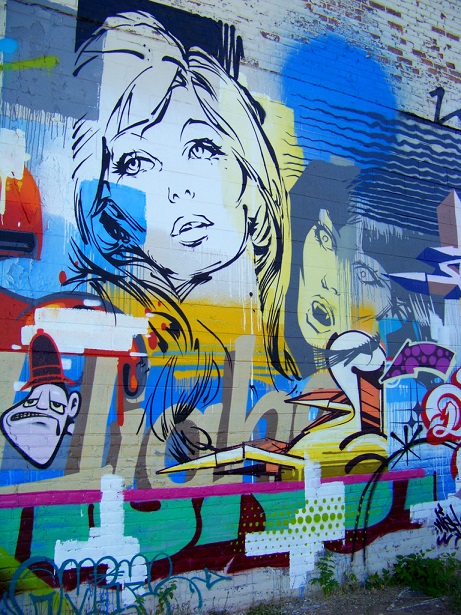
Introduction: Detroit is home to a combination of fifteen covens and packs, plus an additional three nomadic packs that visit the city seasonally. The city's eighty-plus Sabbat take their toll on the mortals of Detroit, through in truth, even the archbishop fails to keep a full tally of the Cainites of Motor City.
American Gods
- -- Squid -- Tzimisce Tattoo Artist
- -- Grease Monkey -- Malkavian Hot-Rod Enthusiast
- -- Lahshonda Tod -- Graffiti Artist
- -- Morena Quinones -- Daughter of Cacophony
- -- Ruggero Romero -- Film student
Cerberus: Newcomers to Detroit
Cerberus is a relatively new pack and not just to Detroit.
- --
- --
- --
Eastside Hoodoo Posse: White gangsta wannabees
- --
- --
- --
- --
- --
Finger Lickin' Good
- --
- --
- --
- --
- --
Flight of Devils
- --
- --
- --
- --
- --
Gangsta Funk
- -- Dekeeya Grant -- Ductus -- Brujah Antitribu
- -- Chill-C -- Pack Priest -- Brujah Antitribu
- --
- --
Gilded Age
- --
- --
- --
- --
- --
Grave Interest: A Coven of Necronomists
- --
- --
- --
- --
- -- Ja'ala Eli -- Keeper of Chronicles
Misericorde: A Pack of Blackhand Killers
- --
- --
- --
- --
- --
Money Shot: The Catharist Elite
- --
- --
- --
- --
- --
The Morlocks: The Nosferatu antitribu
- --
- --
- --
- --
- --
Penny Dreadful
- --
- --
- --
- --
- --
Two Demons Fighting: Goth Sabbat
- --
- --
- --
- --
- --
The Prophet's Chosen
- --
- --
- --
- --
- --
Urban Blight
- --
- --
- --
- --
- --
Nomadic Packs
Les Partisans: Parisian French Transplants
Les Partisans are a group of mostly Parisian French Sabbat that came to Detroit after World War II in the company of Dylan Bruce."
- --
- --
- --
- --
- --
Websites
http://en.wikipedia.org/wiki/Detroit
http://abigailanddolley.blogspot.com/2009/12/detroit-case-study-part-1.html
http://www.angelfire.com/de2/detroitpix/
http://www.detroitno2.com/v2/discussions/detroit-masonic-temple-from-grandeur-to-ghetto/
http://thereafterish.com/tag/theatre-bizarre/
http://www.inexpensive-vacation-ideas.com/Things-to-do-in-Detroit.html

